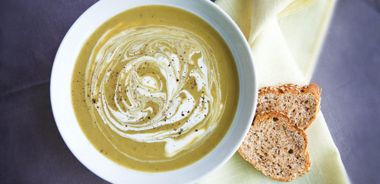Green Monster Soup

The flavour of this no-fuss soup only gets better after a day or two, and it also freezes well. Consider serving with crostini.
1 Tbsp (15 mL) grapeseed oil
2 leeks, thinly sliced
2 garlic cloves, diced
1 Tbsp (15 mL) fresh ginger, minced
4 cups (1 L) low-sodium vegetable broth
2 cups (500 mL) frozen peas
2 cups (500 mL) frozen broccoli florets
1 medium potato, diced
1 tsp (5 mL) dried thyme
1/4 tsp (1 mL) cayenne
Salt and pepper to taste
Juice of 1/2 lemon
1 cup (250 mL) plain, low-fat Greek yogourt
Heat oil in large saucepan over medium heat. Add leeks and cook 3 minutes. Add garlic and ginger; cook 1 minute more. Add vegetable broth, peas, broccoli florets, potato, thyme, cayenne, and salt and pepper. Bring to a boil, reduce heat, and simmer covered for 20 minutes or until potato is tender.
Stir in lemon juice and purée in blender until smooth, in batches if necessary. Return to pot and stir in yogourt; heat through. Do not boil or yogourt will curdle.
Serves 4.
Each serving contains:
221 calories; 14 g protein; 4 g total fat (1 g sat. fat, 0 g trans fat); 35 g carbohydrates; 8 g fibre; 258 mg sodium
source: "Frozen Fruits & Vegetables", alive #351, January 2012





